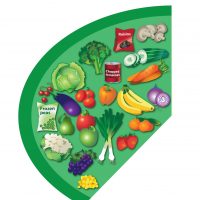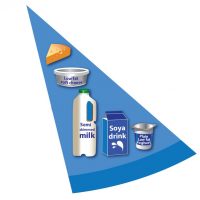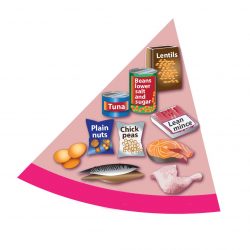
Use the Eatwell Guide to help you get a balance of healthier and more sustainable food. It shows how much of what you eat overall should come from each food group.

Most of us are still not eating enough fruit and vegetables. These should make up over a third of the food we eat every day.
Aim to eat at least 5 portions of fruit and veg each day. Choose from fresh, frozen, tinned, dried or juiced.
The below count as one portion a day, no matter how much you eat.
Fruit and vegetables do not have to be fresh to count, you can also consider:
Some ready-made foods are high in salt, sugar and fat, so only have them occasionally or in small amounts.
You can find the salt, sugar and fat content of ready-made foods on the label.

Starchy food should make up just over a third of the food we eat. Choose higher-fibre, wholegrain varieties such as wholewheat pasta and brown rice, or simple leave skins on potatoes.
There are also higher-fibre versions of white bread and pasta.
Starchy foods are a good source of energy and the main source of a range of nutrients in our diet.
During cooking, aim for a golden yellow colour or lighter when baking, toasting, roasting or frying starchy foods like potatoes, root vegetables and bread.
Why Do We Need Starchy Foods?
Starchy foods are a good source of energy and the main source of a range of nutrients in our diet. As well as starch, they contain fibre, calcium, iron and B vitamins.
Some people think that starchy foods are fattening but gram for gram they contain fewer than half the calories of fat.Just watch out for the added fats used when you cook and serve them: this is what increases the calorie content.
Wholegrain varieties of starchy foods and potatoes – particularly when eaten with their skins on – are good sources of fibre. Fibre can help keep our bowels healthy and can help us feel full, which means we are less likely to eat too much.

Milk, cheese, yoghurt and fromage frais are good sources of protein and some vitamins, and they are also an important source of calcium, which helps keep our bones strong.
Try to go for lower-fat and lower-sugar products where possible, like 1% fat milk, reduced-fat cheese or plain low-fat yoghurt.
The total fat content of dairy products can vary a lot. To make healthier choices, look at the nutrition information on the label to check the amount of fat, including saturated fat, salt and sugar.
Much of the fat in milk and dairy foods is saturated fat. For older children and adults, eating too much fat can contribute to excess energy intakes, leading to becoming overweight.
A diet high in saturated fat can also lead to raised levels of cholesterol in the blood, and this can put you at increased risk of a heart attack or stroke.
There are a number of alternative foods and drinks available in supermarkets to replace milk and dairy products, such as:
Soya milks, yoghurts and some cheeses
Rice, oat, almond, hazelnut, coconut, quinoa and potato milks
Foods that carry the “dairy-free” or “suitable for vegans” signs

Protein is essential for growth and repair of the body and maintenance of good health as all of our cells and tissues contain protein. Protein provides the body with approximately 10 to 15% of its dietary energy and it is the second most abundant compound in the body, following water. A large proportion of this will be muscle (43% on average) with significant proportions being present in skin (15%) and blood (16%).
These foods are good sources of protein, vitamins and minerals. Choose lean cuts of meat and mince and eat less red and processed meat like bacon, ham and sausages.
If you currently eat more than 90g (cooked weight) of red and processed meat a day, the Department of Health advises that you cut down to 70g, which is the average daily consumption in the UK – as there is likely to be a link between red and processed meat and bowel cancer.
Meats such as chicken, pork, lamb and beef are all rich in protein. A balanced diet can include protein from meat, as well as from non-animal sources such as beans and pulses. Red meat provides us with iron, and meat is also one of the main sources of vitamin B12.
Food hygiene is important when storing, preparing and cooking meat.
Aim for at least 2 portions of fish every week – 1 of which should be oily, such as salmon or mackerel.
Fish that is steamed, baked or grilled is a healthier choice than fried fish. Frying can increase the fat content of fish and shellfish, especially when cooked in batter.
To ensure there are enough fish to eat now and in the future, we should try to eat a wide variety of fish and to buy fish from sustainable sources.
There is no recommended limit on how many eggs people should eat.
Eggs can be enjoyed as part of a healthy, balanced diet, but it’s best to cook them without adding salt or fat. For example:
A pulse is an edible seed that grows in a pod. Pulses include all beans, peas and lentils, such as:
As well as being a great source of protein, pulses are also a good source of iron, add fibre and 80g will count as one of your 5 A Day!
Pulses are often bought in tins. If you buy tinned pulses, check the label and try to choose ones that have no added salt or sugar.

Unsaturated fats are healthier fats and include vegetable, rapeseed, olive and sunflower oils.
Remember all types of fat are high in energy and should be eaten sparingly.
A small amount of fat is an essential part of a healthy, balanced diet. Fat is a source of essential fatty acids, which the body cannot make itself.
Fat helps the body absorb vitamins A, D and E. These vitamins are fat-soluble, meaning they can only be absorbed with the help of fats.
Too much fat in your diet, especially saturated fats, can raise your cholesterol, which increases the risk of heart disease.
Current UK government guidelines advise cutting down on all fats and replacing saturated fat with some unsaturated fat.

Water, lower-fat milks and lower-sugar or sugar-free drinks including tea and coffee all count.
Fruit juice and smoothies also count towards your fluid consumption, but they contain free sugars that can damage teeth, so limit these drinks to a combined total of 150ml per day.
Water is a healthy and cheap choice for quenching your thirst at any time. It has no calories and contains no sugars that can damage teeth.
Plain tea, fruit tea and coffee (without added sugar) can also be healthy.
If you don’t like the taste of plain water, try sparkling water or add a slice of lemon or lime. Or heat the water and infuse a tea bag, some coffee or a slice of lemon.
You could also add some no-added-sugar squash or fruit juice for flavour.

These foods include chocolate, cakes, biscuits, sugary soft drinks, butter, ghee and ice cream.
They’re not needed in the diet and so should be eaten less often and in smaller amounts.